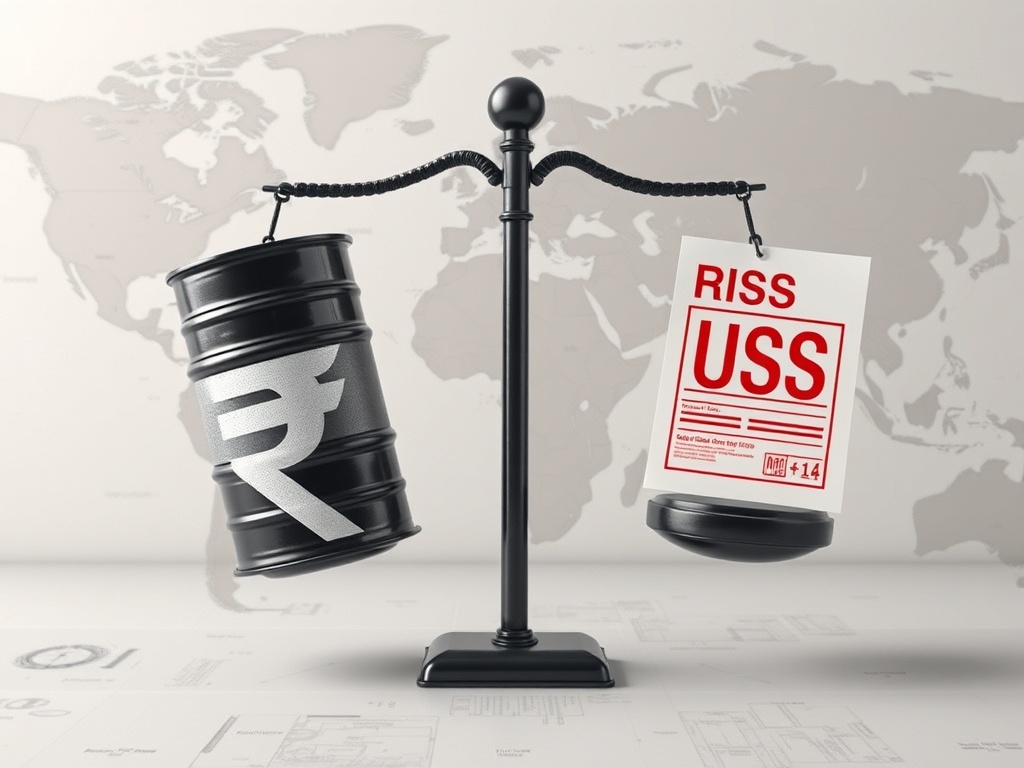BitcoinWorld

Indian Rupee’s Perilous Path: Navigating US Tariffs and Russian Oil Sanctions
In an increasingly interconnected world, economic tremors in one region can send ripples across continents, affecting everything from traditional stocks to the volatile cryptocurrency market. For those tracking global finance, the current challenges facing the Indian Rupee are a prime example of this interconnectedness. As the specter of new US tariffs and the ongoing implications of Russian oil sanctions loom large, India’s currency finds itself at a critical juncture. Understanding these pressures is not just for economists; it offers vital insights into broader market stability and potential shifts in global trade dynamics that can influence investment decisions across all asset classes.
What Role Do US Tariffs Play in Pressuring the Indian Rupee?
The imposition of tariffs by major economies, particularly the United States, can significantly disrupt global trade flows and currency valuations. When the US considers or implements new tariffs, it creates a cascade of effects that can directly and indirectly impact the Indian Rupee. Tariffs are essentially taxes on imported goods. Their primary goal is often to protect domestic industries or to exert political leverage.
For India, the impact of potential US tariffs can be multifaceted:
- Reduced Export Competitiveness: If the US imposes tariffs on Indian goods, Indian exports become more expensive for American buyers. This can lead to a decrease in demand for Indian products, subsequently reducing India’s export earnings. A decline in export revenue means fewer US dollars flowing into India, which can weaken the Rupee against the dollar.
- Supply Chain Disruptions: Tariffs can force companies to re-evaluate their global supply chains. If Indian components or finished goods face tariffs, multinational corporations might seek alternative suppliers outside India. This shift can further hurt India’s manufacturing sector and its overall trade balance.
- Investor Sentiment: The uncertainty surrounding trade disputes can deter foreign direct investment (FDI) into India. International investors might become hesitant to commit capital if they perceive a risk of trade wars impacting profitability. Reduced FDI can lead to capital outflows, putting downward pressure on the Indian Rupee.
- Inflationary Pressures: While tariffs are on imports, their impact can ripple through the domestic economy. If India retaliates with its own tariffs on US goods, or if the cost of imported components rises due to tariffs, domestic production costs can increase, contributing to inflation.
Historically, trade tensions have proven to be significant drivers of currency volatility. The prospect of renewed trade friction between major economies creates an environment of caution for investors, often leading to a flight to perceived safer assets, and a depreciation of emerging market currencies like the Indian Rupee.
How Do Russian Oil Sanctions Affect India’s Energy Security and the Rupee?
India is a major oil importer, and global crude oil prices have a profound impact on its economy and currency. The sanctions imposed on Russian oil by Western nations, while creating opportunities for India to purchase discounted crude, also introduce complex challenges that weigh on the Indian Rupee.
Here’s how Russian Oil Sanctions play out for India:
- Balancing Act of Discounted Oil: India has been a significant buyer of discounted Russian crude oil since the sanctions began. This has provided some relief to its import bill, potentially saving billions of dollars. However, this strategy comes with geopolitical risks, as it can strain relationships with Western allies who are enforcing the sanctions.
- Global Oil Price Volatility: Despite India’s access to discounted Russian oil, the broader global crude oil market remains volatile due to the sanctions. Any disruption in supply, or changes in demand, can send prices soaring. Higher global oil prices directly increase India’s import bill in US dollars, leading to a higher demand for dollars and thus weakening the Indian Rupee.
- Inflationary Impact: Energy costs are a significant component of inflation. Even with discounted Russian oil, the overall elevated global energy prices contribute to higher domestic fuel costs, impacting transportation, manufacturing, and consumer prices. This persistent inflation erodes the purchasing power of the Rupee.
- Current Account Deficit Pressure: India runs a current account deficit, largely driven by its energy imports. High global oil prices exacerbate this deficit, meaning India is spending more foreign currency on imports than it earns from exports. A widening current account deficit is a classic indicator of currency weakness.
The geopolitical landscape surrounding Russian Oil Sanctions is constantly evolving. While India has navigated this terrain adeptly so far, the long-term implications for energy security, trade relations, and the consistent pressure on the Indian Rupee remain a critical concern.
What Are the Indian Rupee’s Vulnerabilities in the Current Global Economy?
Beyond the specific pressures from US tariffs and Russian Oil Sanctions, the Indian Rupee faces inherent vulnerabilities stemming from India’s economic structure and its integration into the Global Economy. These factors amplify the impact of external shocks.
Key vulnerabilities include:
- High Dependence on Oil Imports: As mentioned, India imports over 80% of its crude oil requirements. This makes the Rupee highly susceptible to global oil price fluctuations. A surge in oil prices quickly translates into a higher import bill and a weaker currency.
- Current Account Deficit (CAD): India consistently runs a CAD, meaning its total value of imports (goods, services, and transfers) exceeds its total value of exports. While services exports often offset some of this, a persistent deficit indicates a structural demand for foreign currency, which naturally pressures the Rupee.
- Inflationary Pressures: Inflation remains a persistent challenge for India. High food and fuel prices, combined with global supply chain issues, contribute to a high inflation rate. To combat inflation, the Reserve Bank of India (RBI) often raises interest rates, which can attract foreign capital but also slow domestic economic growth.
- Capital Flows and Foreign Exchange Reserves: Emerging markets like India are sensitive to global capital flows. When global interest rates rise (e.g., in the US), foreign investors may pull capital out of India to seek higher returns elsewhere. Such capital outflows deplete India’s foreign exchange reserves, reducing the RBI’s ability to intervene and support the Rupee.
- Global Economic Slowdown: A slowdown in the Global Economy directly impacts demand for Indian exports, reducing foreign currency inflows. This broader economic environment also affects investor confidence, leading to cautious capital allocation.
The confluence of these internal and external factors creates a complex challenge for policymakers aiming to stabilize the Indian Rupee and maintain economic growth. The Rupee’s performance is a barometer of India’s economic health and its resilience against global headwinds.
How Does the Forex Market React to Geopolitical and Economic Pressures?
The Forex Market, or foreign exchange market, is the largest and most liquid financial market globally. It is where currencies are traded, and their values are determined by supply and demand. Geopolitical events and economic pressures like those facing the Indian Rupee cause immediate and significant reactions in this market.
Here’s how the Forex Market typically responds:
- Increased Volatility: Uncertainty breeds volatility. When news of potential tariffs or escalating sanctions emerges, currency traders react swiftly, leading to sharp movements in exchange rates. The Rupee, being an emerging market currency, often experiences heightened volatility during such periods.
- Flight to Safety: During times of global instability, investors often move their capital into perceived ‘safe-haven’ currencies like the US Dollar, Japanese Yen, or Swiss Franc. This increases demand for these currencies and puts downward pressure on riskier or emerging market currencies, including the Indian Rupee.
- Impact on Carry Trade: The carry trade involves borrowing in a low-interest-rate currency and investing in a high-interest-rate currency to profit from the interest rate differential. When economic or geopolitical risks rise, the perceived risk of the high-interest currency increases, leading to an unwinding of carry trades. This means investors sell the higher-yielding currency (like the Rupee) to repay their loans in the lower-yielding one, further weakening the Rupee.
- Central Bank Intervention: Central banks, like the Reserve Bank of India (RBI), closely monitor currency movements. If the Rupee depreciates too rapidly or excessively, the RBI may intervene in the Forex Market by selling US dollars from its foreign exchange reserves to buy Rupees. This increases the demand for Rupees, aiming to stabilize its value. However, such interventions are limited by the size of the reserves.
- Hedging Activities: Businesses engaged in international trade use the Forex Market to hedge against currency risks. During uncertain times, hedging costs can increase as demand for currency derivatives rises, impacting the profitability of international transactions.
For investors, including those in the crypto space, understanding these dynamics is crucial. A weaker Rupee can impact the cost of international transactions, the value of dollar-denominated assets, and the overall economic sentiment that influences investment flows into various markets.
Challenges and Opportunities for India
The current environment presents both significant challenges and potential long-term opportunities for India.
Challenges:
- Inflationary Spiral: The combination of high oil prices, potential tariff-induced cost increases, and a weakening Rupee can create a difficult inflationary spiral, impacting household budgets and corporate profits.
- Widening Trade Deficit: Despite efforts to boost exports, the pressures from imports (especially energy) and potential tariff barriers can lead to a sustained and widening trade deficit.
- Debt Burden: A depreciating Rupee makes dollar-denominated external debt more expensive to service for Indian companies and the government.
- Reduced Foreign Investment: Sustained uncertainty and economic headwinds can deter foreign capital inflows, which are vital for infrastructure development and economic growth.
Opportunities:
- Boost to Domestic Manufacturing: Tariffs on imports could, in the long run, incentivize domestic production, aligning with the ‘Make in India’ initiative.
- Diversification of Trade Partners: The need to navigate sanctions and tariffs can push India to diversify its trade relationships and seek new markets for its exports and imports.
- Renewable Energy Push: The volatility in fossil fuel prices underscores the urgency for India to accelerate its transition to renewable energy sources, reducing its reliance on imported oil.
- Structural Reforms: The pressure points can act as catalysts for deeper economic reforms aimed at improving ease of doing business, attracting investment, and boosting productivity.
Actionable Insights for Navigating the Economic Headwinds
Given the complex interplay of global economic forces, what can businesses, individuals, and policymakers do to mitigate risks and capitalize on opportunities?
For Businesses:
- Diversify Supply Chains: Reduce over-reliance on single countries for imports or exports. Explore new markets and sourcing options to build resilience against tariffs and geopolitical risks.
- Hedge Currency Exposure: For companies with significant international trade, actively manage foreign exchange risk through hedging instruments to protect profit margins from Rupee depreciation.
- Focus on Value-Added Exports: Shift towards exporting higher-value goods and services that are less price-sensitive to tariffs.
- Embrace Digitalization: Leverage technology to improve efficiency, reduce costs, and explore new digital export opportunities.
For Individuals and Investors:
- Monitor Inflation: Keep a close eye on inflation trends as it impacts purchasing power and investment returns. Adjust investment strategies accordingly, considering inflation-indexed instruments.
- Diversify Investments: Beyond traditional assets, consider a diversified portfolio that might include exposure to international equities or assets that historically perform well during periods of currency volatility, keeping in mind individual risk tolerance.
- Financial Planning: Prioritize debt reduction and building an emergency fund. A weaker Rupee can make foreign travel and education more expensive.
- Stay Informed: Regularly follow news on global trade, energy markets, and central bank policies to make informed financial decisions.
For Policymakers:
- Fiscal Prudence: Maintain fiscal discipline to avoid adding to inflationary pressures and to preserve resources for counter-cyclical measures.
- Boost Domestic Production: Implement policies that genuinely support domestic manufacturing, reduce import dependence, and enhance export competitiveness.
- Strengthen Forex Reserves: Continue to build robust foreign exchange reserves to provide a buffer against external shocks and enable market intervention when necessary.
- Diplomatic Engagement: Engage proactively in international forums to advocate for fair trade practices and manage geopolitical risks related to energy security.
A Resilient Path Forward for the Indian Rupee?
The Indian Rupee is undoubtedly facing a challenging period, caught between the crosscurrents of potential US tariffs and the complex implications of Russian Oil Sanctions. These external pressures, combined with India’s inherent economic vulnerabilities, demand careful navigation by policymakers, businesses, and individuals alike. While the immediate outlook may present headwinds, India’s underlying economic strengths, including its large domestic market and growing digital economy, offer a foundation for resilience. The ability to adapt to changing global dynamics, pursue strategic reforms, and diversify economic relationships will be key to ensuring the long-term stability and strength of the Indian Rupee within the volatile Global Economy and Forex Market. The journey ahead will test India’s economic fortitude, but with prudent management and adaptive strategies, a path towards stability and growth remains achievable.
To learn more about the latest Forex market trends, explore our article on key developments shaping the Indian Rupee’s liquidity and institutional adoption.
This post Indian Rupee’s Perilous Path: Navigating US Tariffs and Russian Oil Sanctions first appeared on BitcoinWorld and is written by Editorial Team





